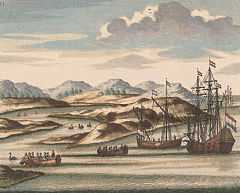Willem de Vlamingh
.jpg)
Willem Hesselsz de Vlamingh (28 November 1640, Oost-Vlieland – 1698 or later) was a Dutch sea-captain who explored the central west coast of Australia (then "New Holland") in the late 17th century.
De Vlamingh and the VOC
De Vlamingh joined the VOC (Dutch East India Company) in 1688 and made his first voyage to Batavia in the same year. Following a second voyage, in 1694, he was asked to mount an expedition to search for the Ridderschap van Holland, a VOC capital ship that was lost with 325 passengers and crew on its way to Batavia in 1694. VOC officials believed it might have run aground on the west coast of New Holland.
De Vlamingh's rescue mission

In 1696, Willem de Vlamingh commanded the rescue mission to Australia's west coast to look for survivors of the Ridderschap van Holland that had gone missing two years earlier. The mission proved fruitless, but along the way Vlamingh charted parts of the continent's western coast and as a result improved navigation on the Indian Ocean route from the African Cape of Good Hope to the Dutch East Indies. There were three ships under his command: the frigate De Geelvink, captained by de Vlamingh himself; the De Nijptang, under Captain Gerrit Collaert; and the galiot Weseltje, under Captain Joshua de Vlamingh, son of Willem de Vlamingh. The expedition departed Amsterdam on 2 May 1696 and sailed to Tristan de Cunha and Saint Peter and Paul Rocks.
- On 29 December 1696, he landed on Rottnest Island. He saw numerous quokkas (a native marsupial) there, and thinking they were large rats he named the island "rats' nest" (Rattennest in Dutch) because of them. He afterwards wrote of it in his journal: "I had great pleasure in admiring this island, which is very attractive, and where it seems to me that nature has denied nothing to make it pleasurable beyond all islands I have ever seen, being very well provided for man's well-being, with timber, stone, and lime for building him houses, only lacking ploughmen to fill these fine plains. There is plentiful salt, and the coast is full of fish. Birds make themselves heard with pleasant song in these scented groves. So I believe that of the many people who seek to make themselves happy,there are many who would scorn the fortunes of our country for the choice of this one here, which would seem a paradise on earth".[1]

- On 10 January 1697, he ventured up the Swan River. He and his crew are believed to have been the first Europeans to do so. He named the Swan River (Zwaanenrivier in Dutch) after the large numbers of black swans that he observed there.
- On 4 February 1697, he landed at Dirk Hartog Island, Western Australia, and replaced the pewter plate left by Dirk Hartog in 1616 with a new one that bore a record of both of the Dutch sea-captains' visits. The original plate is preserved in the Rijksmuseum in Amsterdam.[2]

De Vlamingh with his son and Collaert, commanded a return fleet from the Indies on 3 February 1698, arriving in his hometown Amsterdam on 16 August. On an earlier retourship, De Vlamingh had sent Nicolaes Witsen a box with seashells, fruits and vegetation from New Holland (Australia) as well as eleven drawings that Victor Victorsz had made on the expedition. The gifts also included some black swans, but these had died on the voyage. Witsen offered the drawings to Martin Lister.[3] Witsen, who had invested in the journey, was disappointed the men had been more interested in setting up trade than in exploring.[4] In 1699 William Dampier would explore the coast of Australia and New Guinea.
References
- ↑ Quoted in Phillip E. Playford, Voyage of Discovery to Terra Australis: by Willem De Vlamingh, 1696-97, Western Australian Museum, Perth, 1998, p.84.
- ↑ "Hartog & de Vlamingh Plates". Western Australian Museum. Retrieved 2010-05-18.
- ↑ Smit, P & A.P.M. Sanders & J.P.F. van der Veen (1986) Hendrik Engel's Alphabetical List of Dutch Zoological Cabinets and Menageries, p. 306.
- ↑ Heeres, J.E. (1899) The part borne by the Dutch in the discovery of Australia 1606-1765, p. XVI, 83.
- Notes
Further reading
- Playford, Phillip E.(1998) Voyage of discovery to Terra Australis : by Willem de Vlamingh in 1696-97 Perth, W.A. Western Australian Museum. ISBN 0-7307-1221-4
| Wikimedia Commons has media related to Willem de Vlamingh. |
|